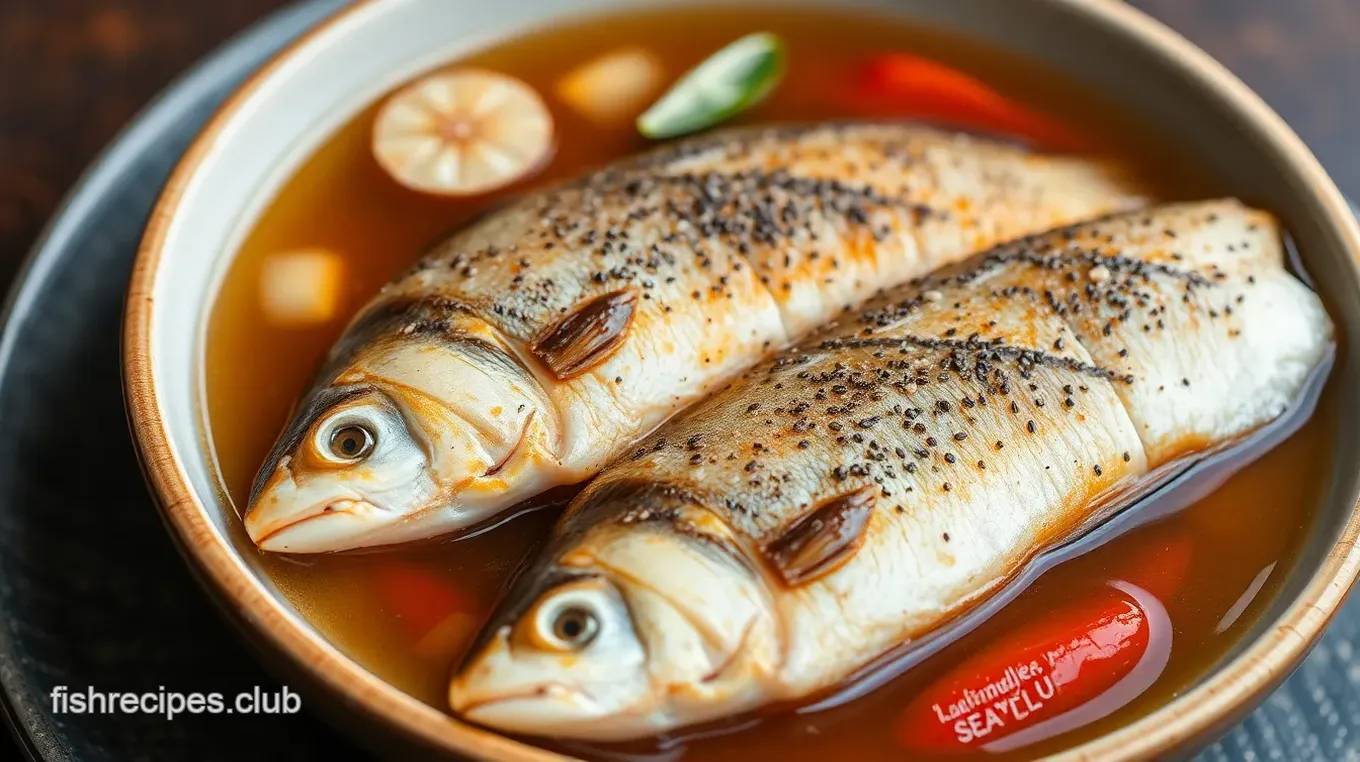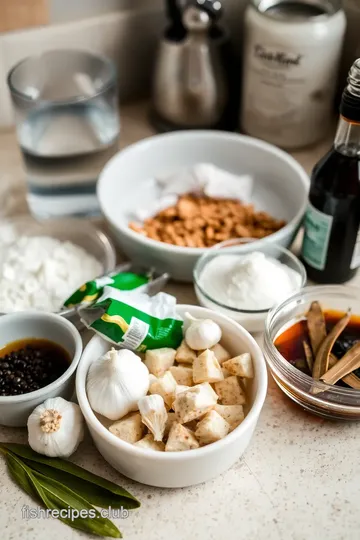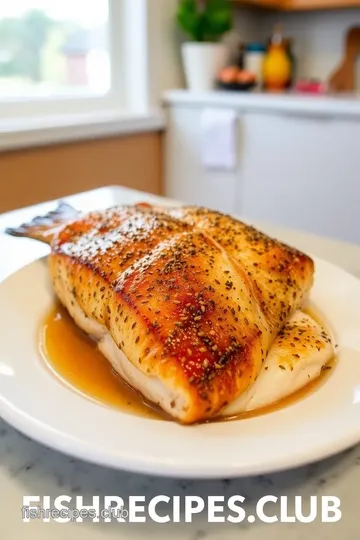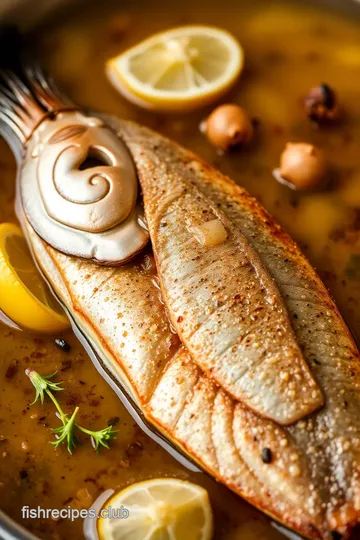Flavorful Smoked Fish: A Brining Adventure!
Craving the best Smoke Fish with Flavorful Brine in 24 Hours? Try my simple herb-glazed version! So juicy and flavorful, it's perfect for weeknights or holidays. Get my tips inside!

- look into Into Flavor: The Art of Smoking Fish with Flavorful Brine in 24 Hours
- Essential Ingredients Guide
- Mastering the Art of Professional Cooking
- Pro Tips & Secrets for Smoking Fish
- Perfect Presentation Tips
- Storage & Make-Ahead Tips
- Creative Variations to Elevate Your Recipe
- Complete Nutrition Guide
- Wrapping It Up
- Frequently Asked Questions
- Recipe Card
look into Into Flavor: The Art of Smoking Fish with Flavorful Brine in 24 Hours
Let me take you to a sunny saturday a couple of years back. i was hanging out with my buddies by the lake, and one of them pulls out the most incredible smoked salmon i had ever had.
I was like, “whoa, how did you make this?” turns out, it was all about a 24-hour brine technique that transformed fresh fish into this savory delight.
Since then, i've been on a mission—learning how to smoke fish with flavorful brine in 24 hours has become a staple in my kitchen.
If you love outdoor cooking tips and smoked delights, you’re in for a treat!
The Smoky Story Behind the Recipe
Smoking fish is an age-old tradition that goes way back, all the way to our ancestors who knew that preserving fish with wood smoke could help it last longer.
Isn’t that cool? people have been enjoying smoked fish for centuries. fast forward to today, and this method has taken off! from humble backyard gatherings to fancy dinner parties, everyone wants a taste of that smoky goodness.
Now, if we’re keeping it real here, the brining time for fish requires some patience—but trust me, it’s worth every second.
Prep time is about 15 minutes (easy peasy), but throw in a solid 24 hours of brining , and you’ll have tender, flavorful fish that’s the talk of the town.
And don’t worry about breaking the bank; with just a few flavorful brine ingredients , overall costs stay super low while you yield around four hearty servings.
Benefits of Your Smoky Creation
Let’s chat about some perks here. first off, smoked fish is loaded with nutrients! you’re getting your protein fix, plus healthy omega-3 fatty acids.
Honestly, it’s a quick and tasty way to jazz up your diet. plus, smoking fish provides unique flavors that you just can't replicate with regular cooking.
Oh, and when it comes to special occasions, nothing beats a beautiful platter of homemade smoked salmon at a barbecue or weekend brunch.
You can impress your guests with that aromatic citrus brine for fish that sings of summer. not to mention, you can easily personalize this recipe—whether you wanna go the smoked trout route or switch things up with different wood chip flavors for smoking .
And if you’re wondering why this method stands out? it’s all about that brining fish for flavor . this technique doesn’t just season the fish; it enhances its natural characteristics.
So much flavor in every bite!
Transitioning to the Ingredients
Now, i can't wait to share the step-by-step guide and what goes into this magical brining adventure. we’re about to unlock the secrets of easy smoked fish recipes that you can whip up without a hitch! if you're ready to dive into the world of flavorful fish, gather your ingredients and put on your chef's hat! this is gonna be fun.
So let’s get into it—the ingredients are calling, and you’ll want to have them handy for this delicious journey!

Essential Ingredients Guide
Hey there, friends! let’s talk about the essentials that can make or break your cooking game. whether you’re whipping up an easy smoked fish recipe or trying your hand at mom’s signature spaghetti, having the right ingredients and tools is everything.
So, let’s dive into our essential ingredients guide .
Premium Core Components
First things first, let’s get down to the premium core components .
When you're cooking, detailed measurements are key. for all you measurements nerds, i’m talking about cups and ounces for the us folks and milliliters and grams for our metric friends.
Don’t just eyeball it! trust me, your taste buds will thank you.
Next up, how to tell what's good and what's not. quality indicators for ingredients are your best friend at the grocery store.
For example, when picking fresh fish, look for bright eyes and a clean, ocean-like smell. if it doesn’t smell like the sea, you probably don’t want it on your plate!
Now, the storage guidelines are super important, too. ingredients have their shelf life, and you don't want to find that pasta sauce in the back of your fridge six months later, do ya? always check those expiration dates and store things properly.
On top of that, having some freshness tips can be a game-changer. when picking herbs, go for the vibrant, fragrant ones.
They’ll jazz up your dish like nobody's business. and when you’re buying spices, make sure they’re stored in a cool, dark place—this keeps the flavor alive!
Signature Seasoning Blend
Next, let’s spice things up with a signature seasoning blend . This is where your creativity can really shine, my friends!
Think essential spice combinations —like garlic powder, onion powder, and paprika for that smoky kick. herbs are another game changer; i totally love using dill and thyme when brining fish.
The herb selections you choose can elevate your dishes to next-level delicious.
And hey, don’t forget those flavor enhancers . a sprinkle of lemon zest or a dash of liquid smoke can take your dish from drab to fab.
And depending on where you live, there are some cool regional variations . for example, someone in the south might lean toward a cajun blend, while a west coaster could go for something more citrusy!
Smart Substitutions
Sometimes life happens, and you don’t have what you need in your pantry. That’s where smart substitutions come into play.
Common alternatives can save the day! need dijon mustard but only have yellow? go for it! the world won’t end if you mix things up a bit.
Plus, if you’re adjusting for dietary needs, it's easy to swap out regular ingredients for gluten-free options.
Don’t forget about those emergency replacements . if you’re in a pinch and need to brine fish for flavor but have no kosher salt, try using sea salt instead, just adjust the amount since it can be more potent.
Also, consider seasonal options . In summer, you could use fresh herbs from your garden, and in winter, dried ones work just fine.
Kitchen Equipment Essentials
Alright, let’s chat about what you need in the kitchen. Your kitchen equipment essentials can make cooking a breeze.
Make sure you have those must-have tools—like a good chef’s knife and some reliable cutting boards. Oh, and a meat thermometer? Game-changer when you’re smoking fish!
If you don't have a fancy smoker, don’t sweat it. there are alternative equipment options out there. i've used my gas grill to smoke fish plenty of times! just add those wood chips and you’re golden.
Also, let’s not ignore those preparation tips . Clean as you go! It keeps your kitchen organized and makes cooking so much more enjoyable.
And of course, don’t overlook storage solutions . Organize your spices and ingredients for easy access. It makes cooking less of a headache!
Now that we've got the essentials in place, you're ready to dive into cooking like a pro. so, why not take that plunge? follow the next section where we will tackle the exciting process of how to smoke fish with flavorful brine in 24 hours .
Trust me, your taste buds are gonna love this one!

Mastering the Art of Professional Cooking
When it comes to cooking like a pro, it all starts with professional methods . cooking is more than just throwing ingredients in a pan; it’s about preparation, timing, and, let’s be real, a good dash of love.
So, let’s break down how to nail your kitchen game and create amazing dishes—like how to smoke fish with flavorful brine in 24 hours —that’ll have your friends raving.
Essential Preparation Steps
Imagine you’re in the kitchen, excitement buzzing like a pot ready to boil. you gotta be ready, right? enter mise en place , which is just a fancy french term that means “everything in its place.
” seriously, folks, gather your ingredients before you start cooking. chop that garlic, measure the salt and sugar, and get your fish prepped.
You’ll feel like a superstar chef!
Now, let’s talk about time management tips . timing is crucial. while your fish is brining, you can clean up the mess or prep other dishes.
Multitasking can be your best friend in the kitchen!
And then there’s organization . keep your workspace tidy. grab a bowl for scraps, and don’t let that fishy smell linger.
It’s a game-changer for both your cooking and your sanity. speaking of sanity, think safety! always wash your hands after handling raw fish and use separate cutting boards.
No one wants a food mishap, am i right?
Step-by-Step Process
Now, onto actually cooking. Here’s where you want to follow clear, numbered instructions. When you’re brining fish for flavor , the steps are straightforward:
-
Prepare the brine : combine your water, kosher salt, brown sugar , and other flavorful ingredients in a saucepan. heat it until everything dissolves.
This is where the magic happens—think about all those flavorful brine ingredients kicking in!
-
Brine the fish : place those beautiful fillets in a resealable bag, pour the cooled brine over them, and seal it up tight.
Pop it in the fridge for 24 hours . yep, you heard it right: 24-hour brine technique is key.
-
Prepare for smoking : rinse and dry your fish after the brining time. let them sit at room temperature for about 30 minutes .
This is when they develop a bit of a tacky surface—a pellicle, they call it! fancy, huh?
-
Smoke the fish : preheat your smoker to 180° f - 220° f ( 82° c - 104° c) . this is critical; too hot and dry fish isn’t what we’re after.
Smoke for 2 to 4 hours , depending on your fish type. test for doneness—if it flakes easily and hits an internal temperature of 145° f ( 63° c) , you’re golden!
-
Serve and Enjoy! : Let it cool a bit, slice it up, and enjoy this homemade delicacy. Trust me, you’ll feel like a culinary wizard.
Expert Techniques
Want to elevate your cooking game? let’s hone in on some expert techniques . first off, experiment with your wood chip flavors for smoking .
Cherry for a subtle sweetness, hickory for kick? the world is your oyster!
Also, don’t forget quality checkpoints. check that smoker temperature and make sure your fish is resting properly. and you know what? if things go sideways—like overcooked fish—just shred it up and toss it in a salad! you can fix nearly anything.
Success Strategies
Here’s where i drop some knowledge about common mistakes to avoid . don’t rush the brining process; it’s where the flavor gets locked in.
And definitely don’t skip the resting step after smoking; it keeps your fish moist.
For the best quality assurance, take notes—literally! Note what works and what doesn’t for future reference. Seriously, it’s like keeping a journal for your flavor-packed adventures.
Got a busy schedule? Try some make-ahead options . You can smoke your fish and freeze it. Boom, you have healthy smoked fish options ready to go!
So there you have it! with these tips and tricks, you’ll smoke fish that delivers flavor and tenderness, impressing everyone around.
Just remember: cooking is about having fun, so don’t stress if things don’t go perfectly.
Feeling inspired? Great! Let’s transition now to explore some Additional Information .

Pro Tips & Secrets for Smoking Fish
When it comes to making an amazing smoked fish recipe , you'll want a few chef's secrets up your sleeve.
Start with a 24-hour brine technique that takes your fish from basic to bold. my go-to for flavor is to use a mix of kosher salt, brown sugar , and those spicy little touches, like peppercorns and red pepper flakes .
Here’s a little time-saving trick. if you have a busy day, consider brining the fish overnight. you can easily toss it in and forget about it until the next day! honestly, the longer it brines, the more intense the flavor.
If you're feeling a bit experimental, you can even add citrus zest or sprigs of fresh herbs into that brine.
Let’s talk presentation because we all know we eat with our eyes first! serve your smoked fish on a colorful platter.
Add vibrant garnishes like fresh herbs or lemon slices. honestly, it makes all the difference!
Perfect Presentation Tips
Let’s make your smoked fish look as good as it tastes! after smoking, it’s all about how you plate it.
A simple yet effective technique? layer the fish on a platter with colorful ingredients . think a bed of greens or even a bright salsa!
For garnish, a drizzle of olive oil or citrus-infused vinegar can bring that dish to life. and don’t forget to play up those colors! arrange your smoked fish beside some seasonal veggies or colorful salads.
Honestly, food should look as good as it tastes, right? Your guests will be snapping pics before they even take a bite!
Storage & Make-Ahead Tips
Now, let’s chat about what happens when you’re done smoking that perfect fish. storage guidelines say that your homemade smoked fish can last in the fridge for about 5 to 7 days .
But if you want to keep it longer, vacuum sealing it before freezing is the way to go! just remember to use freezer-safe bags .
When it’s time to enjoy your fish again, you can let it thaw in the fridge overnight. for a quick reheat, pop it in a pan on low heat, and it’ll warm right up without losing that scrumptious flavor.
Just make sure the internal temp is back up to 145° f before serving!
Creative Variations to Elevate Your Recipe
Let’s get a little wild with those smoking fish variations ! craving something spicy? try adding smoked paprika to your brine or even a dash of cayenne pepper.
It’ll kick up the flavor a notch.
Seasonal twists can also keep things fresh. in summer, try using a citrus brine with limes and oranges. in the fall, switch it up with darker spices like cinnamon or nutmeg.
Trust me, it’ll give your fish a unique flavor profile!
If anyone in your crew is watching their sodium, try using a lower-sodium salt in the brine. you can still make that fish pop with flavors through herbs or sweeter substitutions like maple syrup instead of sugar.
Complete Nutrition Guide
Now that we’ve covered flavor, let’s not forget the nutrients. did you know smoked fish packs a punch? each serving can give you around 30 grams of protein with a decent dose of omega-3 fatty acids.
These are great for heart health, too!
Make sure to keep portions in check, especially if you’re pairing it with rich sides. honestly, this keeps it a healthy indulgence.
Aim for about 4 ounces of smoked fish per serving, and you’re doing great.
So, if you’re considering a fun outdoor cookout or just looking to enjoy a little bit of gourmet at home, this method to Smoke Fish with Flavorful Brine in 24 Hours is a total game-changer! You’ll impress your friends and family with your culinary skills, and, let’s be real, you’ll be the star of the BBQ!
Wrapping It Up
To sum it all up, diving into the world of smoking fish can be incredibly rewarding. with some easy-to-follow recipes, pro tips, and a sprinkle of your creativity, you'll be on your way to serving amazing smoked fish that everyone will devour.
So why not give it a go? your next backyard party could very well be the talk of the neighborhood! happy cooking, my friends!
Frequently Asked Questions
How long do I need to brine the fish for the best results when I smoke fish with flavorful brine in 24 hours?
Brining the fish for a full 24 hours is ideal, as it allows the flavors to penetrate thoroughly while also helping to preserve the fish. If you're short on time, try a minimum of 12 hours, but remember that longer brining enhances the flavor and texture significantly.
What types of fish work best for smoking, and can I use frozen fish?
Fish such as salmon, trout, and mackerel are particularly well-suited for smoking due to their rich flavors and healthy fat content. You can use frozen fish; however, make sure to thoroughly thaw it and pat it dry to avoid excess moisture affecting the brining and smoking process.
What wood chips should I use for smoking the fish?
Hickory and cherry wood chips are popular choices for smoking fish, imparting delicious aromatic flavors. You might also experiment with apple or alder wood for a milder, sweeter smoke that complements the fish's natural taste.
Can I adjust the flavor of the brine for smoking fish for a different taste experience?
Absolutely! You can customize the brine by adding herbs like dill or thyme, or even spices such as coriander or cumin. Always remember to taste your brine before adding the fish to ensure it meets your flavor preferences.
How should I store leftover smoked fish, and how long does it last?
Store any leftover smoked fish in an airtight container in the refrigerator for up to a week. You can also freeze it for up to three months; just wrap it tightly in plastic wrap, followed by aluminum foil, to maintain its quality and flavor.
What are some nutritional benefits of smoking fish with flavorful brine?
Smoking fish not only enhances its flavor but also provides numerous health benefits. Fish is a great source of protein and omega-3 fatty acids, which are beneficial for heart health. Additionally, using a flavorful brine can help retain moisture and enhance the overall nutritional profile of the dish.
Flavorful Smoked Fish: A Brining Adventure! Card

⚖️ Ingredients:
- 1 cup (240 mL) water
- 1/2 cup (100 g) kosher salt
- 1/4 cup (50 g) brown sugar
- 1 tablespoon (15 g) black peppercorns
- 2 cloves garlic, minced
- 1 teaspoon (5 g) red pepper flakes
- Zest of 1 lemon
- 1/2 cup (120 mL) fresh lemon juice
- 2 pounds (900 g) fresh fish fillets (salmon, trout, or mackerel)
- 2 cups wood chips (such as hickory or cherry), soaked in water
🥄 Instructions:
- Step 1: In a saucepan, combine water, salt, brown sugar, peppercorns, minced garlic, red pepper flakes, lemon zest, and lemon juice. Heat until salt and sugar dissolve; let cool.
- Step 2: Place fish fillets in a resealable bag or container; pour cooled brine over fish. Seal and chill in the refrigerator for 24 hours.
- Step 3: Remove fish from brine; rinse under cold water and pat dry with paper towels. Allow fish to rest on a rack for 30 minutes to develop a pellicle.
- Step 4: Preheat smoker or grill to 180°F - 220°F (82°C - 104°C). Place fish on grill grates; add soaked wood chips to the smoker or directly on coals.
- Step 5: Smoke for 2 to 4 hours, until fish flakes easily with a fork and reaches an internal temperature of 145°F (63°C).
- Step 6: Let fish cool briefly before serving. Enjoy!
Previous Recipe: Easy & Juicy Grilled Mullet Fish with Zesty Flavor: My Fail-Proof Herb Glazed Method
Next Recipe: Easy & Juicy Steam Cod Fish with Fresh Herbs Delight: My Go-To Herb-Infused Method
